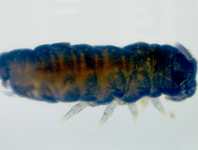Abstract
The controversial dinosauriform Teyuwasu barberenai Kischlat, 1999 (Fig. 1B) is based on a right femur (BSPG AS XXV 53) and tibia (BSPG AS XXV 54), formerly referred to the pseudosuchian ‘Hoplitosuchus raui’ (= Hoplitosaurus raui) Huene, 1938 (see also Huene, 1942). This material comes from a classic Late Triassic (Carnian) locality in southern Brazil (Fig. 1A), the Cerro da Alemoa outcrop on the Alemoa complex, that has yielded several noteworthy tetrapod specimens (see Garcia et al., 2019, for a complete list of references). When reviewing these abovementioned materials, Kischlat (1999) considered it to belong to a “robust saurischian dinosaur”, but later this taxon was considered to be a nomen dubium (Langer et al., 2010; Ezcurra, 2012). Foremost, the initial description of this taxon is problematic, because Kischlat (1999) presented it in a symposium abstract which does not constitute a published work [which is not allowed under the Art. 9.10 of the International Commission on Zoological Nomenclature (ICZN)]. Moreover, the author did not list traits that clearly differentiated Teyuwasu from other coeval dinosauriforms (cf. Art. 13 of the ICZN, see further below). In particular, it was not adequately distinguished from Staurikosaurus pricei Colbert, 1970 (Fig. 1B), which also comes from the same Alemoa complex, but from another nearby outcrop (Sanga Grande/Sanga de Baixo) considered equivalent in stratigraphic level and horizon with the lower levels of the Cerro da Alemoa site (Huene, 1942; Colbert, 1970; see also Garcia et al., 2019) (Fig. 1A). However, Huene (1942) did not clearly specify that the materials (femur and tibia) later assembled by Kischlat (1999) into the holotype of Teyuwasu were found in close association, although Huene (1942) cited that they come from the same stratigraphical level and horizon, and to our interpretation, their morphology and preservational features are compatible. Still, assigning these bones as part of a single individual is tentative.
References
Alcober, O.A. & Martinez, R.N. (2010) A new herrerasaurid (Dinosauria, Saurischia) from the Upper Triassic Ischigualasto Formation of northwestern Argentina. ZooKeys, 63, 55–81.
https://doi.org/10.3897/zookeys.63.550
Bittencourt, J.S. & Kellner, A.W.A. (2009) The anatomy and phylogenetic position of the Triassic dinosaur Staurikosaurus pricei Colbert, 1970. Zootaxa, 2079, 1–56.
Bittencourt, J., Arcucci, A., Marsicano, C. & Langer, M. (2014) Osteology of the Middle Triassic archosaur Lewisuchus admixtus Romer (Chañares Formation, Argentina), its inclusivity, and relationships amongst early dinosauromorphs. Journal of Systematic Palaeontology, 13 (3), 189–219.
https://doi.org/10.1080/14772019.2013.878758
Butler, R.J., Smith, R.M. & Norman, D.B. (2007) A primitive ornithischian dinosaur from the Late Triassic of South Africa, and the early evolution and diversification of Ornithischia. Proceedings of the Royal Society B: Biological Sciences, 274 (1621), 2041–2046.
https://doi.org/10.1098/rspb.2007.0367
Cabreira, S.F., Kellner, A.W.A., Dias-da-Silva, S., Roberto-da-Silva, L., Bronzati, M., Marsola, J.C., Müller, R.T., Bittencourt, J.S., Batista, B.J., Raugust, T., Carrilho, R. & Langer, M.C. (2016) A unique Late Triassic dinosauromorph assemblage reveals dinosaur ancestral anatomy and diet. Current Biology, 26, 3090–3095.
https://doi.org/10.1016/j.cub.2016.09.040
Colbert, E.H. (1970) A saurischian dinosaur from the Triassic of Brazil. American Museum Novitates, 2405, 1–39.
Cope, E.D. (1889) On a new genus of Triassic Dinosauria. The American Naturalist, 23 (271), 621–633.
https://doi.org/10.1086/274979
Dzik, J. (2003) A beaked herbivorous archosaur with dinosaur affinities from the early Late Triassic of Poland. Journal of Vertebrate Paleontology, 23, 556–574.
Ezcurra, M. (2012) Comments on the taxonomic diversity and paleobiogeography of the earliest known dinosaur assemblages (Late Carnian-Earliest Norian). Historia Natural, 2 (1), 49–71.
Garcia, M.S., Müller, R.T., Da-Rosa, Á.A.S. & Dias-da-Silva, S. (2019) The oldest known co-occurrence of dinosaurs and their closest relatives: a new lagerpetid from a Carnian (Upper Triassic) bed of Brazil with implications for dinosauromorph biostratigraphy, early diversification and biogeography. Journal of South American Earth Sciences, 91, 302–319.
https://doi.org/10.1016/j.jsames.2019.02.005
Holz, M. & Schultz, C.L. (1998) Taphonomy of the south Brazilian Triassic herpetofauna: fossilization mode and implications for morphological studies. Lethaia, 31, 335–345.
https://doi.org/10.1111/j.1502-3931.1998.tb00523.x
Huene, F. (1938) Ein grosser Stagonolepid aus der jungeren Trias Ostafrikas. Neues Jahrbuch fur Mineralogie, Geologie und Palaontologie, 80 (2), 264–278.
Huene, F. (1942) Die fossilen Reptilien des sudamerikanischen Gondwanalandes. Ergebnisse der Sauriergrabungen in Sudbrasilien 1928/29. Becksche Verlegbuchhandlung, Munich, 332 pp.
Kischlat, E.E. (1999) A new dinosaurian “rescued” from the Brazilian Triassic: Teyuwasu barbarenai, new taxon. Paleontologia em Destaque, Boletim Informativo da Sociedade Brasileira de Paleontologia, 14 (26), 58.
Langer, M.C. (2003) The pelvic and hind limb anatomy of the stem-sauropodomorph Saturnalia tupiniquim (Late Triassic, Brazil). PaleoBios, 23, 1–30.
Langer, M.C., Ezcurra, M.D., Bittencourt, J.S. & Novas, F.E. (2010) The origin and early evolution of dinosaurs. Biological Reviews, 84, 1–56.
https://doi.org/10.1111/j.1469-185X.2009.00094.x
Müller, R.T., Langer, M.C. & Dias-da-Silva, S. (2018) An exceptionally preserved association of complete dinosaur skeletons reveals the oldest long-necked sauropodomorphs. Biology Letters, 14 (11). [published online]
https://doi.org/10.1098/rsbl.2018.0633
Nesbitt, S.J., Smith, N.D., Irmis, R.B., Turner, A.H., Downs, A. & Norell, M.A. (2009) A complete skeleton of a Late Triassic saurischian and the early evolution of dinosaurs. Science, 326 (5959), 1530–1533.
https://doi.org/10.1126/science.1180350
Novas, F.E. (1993) New information on the systematics and postcranial skeleton of Herrerasaurus ischigualastensis (Theropoda: Herrerasauridae) from the Ischigualasto Formation (Upper Triassic) of Argentina. Journal of Vertebrate Paleontology, 13 (4), 400–423.
https://doi.org/10.1080/02724634.1994.10011523
Pretto, F.A., Langer, M.C. & Schultz, C.L. (2018) A new dinosaur (Saurischia: Sauropodomorpha) from the Late Triassic of Brazil provides insights on the evolution of sauropodomorph body plan. Zoological Journal of the Linnean Society, 185 (2) 388–416.
https://doi.org/10.1093/zoolinnean/zly028

